Parts of a tree (1): The Bark.
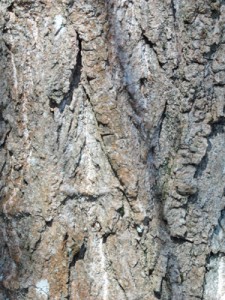
Bark exists to protect a tree from ‘attack’ by the elements, pests, ‘predators’ (animals who would eat it) and disease causing organisms. There is no easy definition of what constitutes bark, a slightly technical definition might be ‘the tissues that lie outside the vascular cambium'. The vascular cambium is a layer of dividing cells that gives rise to xylem tissue and phloem tissue. The cells nearer the centre form the xylem, those towards the outside form the phloem.
The inner part of the bark contains various types of living cells, for example, glands that produce latex (as in natural rubber), oils and resins. Moving outwards, there lies the rhytidome or outer bark, an amalgam of living and dead material - notably cork cells. The cork cells fill with a waxy material - Suberin. Eventually, these cells die and form much of the bulk of the bark. The nature of bark is immensely variable.
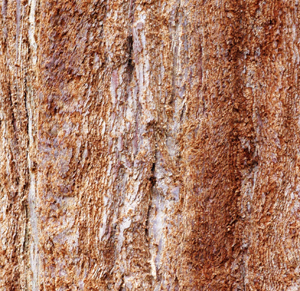 Wind, fire and frost can seriously damage or kill trees but bark helps to protect them. Trees are eminently combustible as is evidenced by the recent forest fires in Australia and California. However, some trees have a very thick bark that can protect them against fire. The cork oak has a bark that can be up to 30 cm thick, it is so thick that it can be harvested periodically without killing the trees. Cork oak is grown extensively in the mediterranean region. Giant Redwoods too are noted for having an extremely thick bark. Their bark is very fibrous and can be up to three feet thick, it offers protection against fire (and rock fall which is also a hazard in their home habitat).
Wind, fire and frost can seriously damage or kill trees but bark helps to protect them. Trees are eminently combustible as is evidenced by the recent forest fires in Australia and California. However, some trees have a very thick bark that can protect them against fire. The cork oak has a bark that can be up to 30 cm thick, it is so thick that it can be harvested periodically without killing the trees. Cork oak is grown extensively in the mediterranean region. Giant Redwoods too are noted for having an extremely thick bark. Their bark is very fibrous and can be up to three feet thick, it offers protection against fire (and rock fall which is also a hazard in their home habitat).
In contrast to cork oak and redwoods, some trees like the eucalypts have a bark that is rich in oils and very flammable. The bark also ‘peels’, strips are shed onto the forest floor. There are many species of Eucalyptus and several different types of bark are recognised.
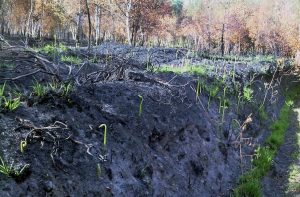
Woodland recovering from a fire
If and when this oil rich bark builds up on the forest floor, it will contribute significantly to the intensity and ferocity of any fire. Indeed, it has been likened to adding petrol to a fire ’3 centimetres of leaf litter can cause a conflagration equivalent to one fuelled by a centimetre of refined gasoline’. The leaves are also rich in oil so the crowns of the trees can also contribute to / exacerbate any fire. The peeling or exfoliation of bark is not restricted to Eucalypts, it can be seen in trees much closer to home - such as the birch. Its bark can be removed in long strips and has been used in covering a canoe or roofing material.
Whilst bark can protect against fire, it can also deter animals - large or small from inflicting damage. For example, there is an African species of Acacia known as knobthorn that has a bark covered with thorn-like structures. These 'thorns' deter elephants from eating the bark. Elephants can consume a lot of vegetation in a day and tree bark is much favoured.
A variety of animals may feed on bark material, for example deer, squirrels, and beavers, but the list could also include orang-utans, rhinos, bush babies and porcupines. North American porcupines use their large front teeth to eat bark and stems. Bushbabies generally feed on insects during the wet seasons, but during drought / dry periods - they feed on the resins / gum that flows from the trees in their woodlands.
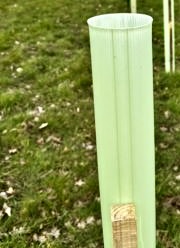 In the UK, a lot of bark damage is done by deer, especially during the winter months when other food sources are limited. In the summer months, male deer rub their heads / antlers against the trunks of trees - inflicting damage. Such activity can prevent regeneration in natural woodlands. Tree guards may be needed to allow young trees to establish themselves (or fencing to create a ‘deer free’ zone). Guards also protect against rabbit damage. Grey squirrels can also cause damage to trees as they gnaw stems to reach the ‘sweet’, sap-filled tissues just below the bark, this activity is usually seen in late Spring and early Summer.
In the UK, a lot of bark damage is done by deer, especially during the winter months when other food sources are limited. In the summer months, male deer rub their heads / antlers against the trunks of trees - inflicting damage. Such activity can prevent regeneration in natural woodlands. Tree guards may be needed to allow young trees to establish themselves (or fencing to create a ‘deer free’ zone). Guards also protect against rabbit damage. Grey squirrels can also cause damage to trees as they gnaw stems to reach the ‘sweet’, sap-filled tissues just below the bark, this activity is usually seen in late Spring and early Summer.
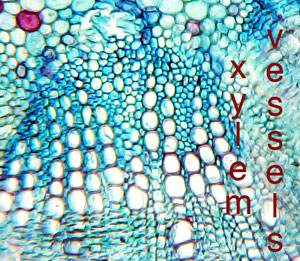
xylem vessels
Whilst bark is broadly protective, it can also offer a home to certain pests. Bark beetles lay their eggs below the bark so that when the larvae hatch, they can feed on the nutrient rich tissue of the cambium and phloem. Bark beetles have been responsible for the loss of millions of trees in the United States and Canada. The scale of the loss is much greater than in the past, when cycles of beetle infestation and fire created a mosaic across the countryside of young and old trees. Ageing stands of trees coupled with warmer winters (which have helped the overwintering stage of the insect) have contributed to the spread of bark beetles. The beetles breed and feed beneath the bark, damaging the phloem and cambium tissue. Consequently, the tree's transport systems begin to fail and the beetles may also introduce disease-causing fungi and bacteria.
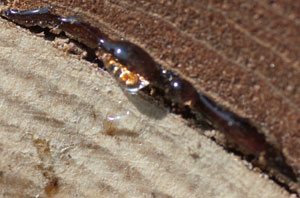 To a certain extent, trees are able to repair damage to their bark but the response is varied according to the nature of the damage and the tree involved. Some trees can produce ‘callus tissue’ that heals over the ‘wound’, leaving a scar. Some trees, such as the pines, produce resins and antimicrobial compounds in response to injury. This sticky resin may trap insect invaders as is witnessed by those trapped in time capsules of amber.
To a certain extent, trees are able to repair damage to their bark but the response is varied according to the nature of the damage and the tree involved. Some trees can produce ‘callus tissue’ that heals over the ‘wound’, leaving a scar. Some trees, such as the pines, produce resins and antimicrobial compounds in response to injury. This sticky resin may trap insect invaders as is witnessed by those trapped in time capsules of amber.
Apart from bark beetles, other animals and plants live in or on bark in a variety of associations, some parasitic as is the case with fungi (like the polypores), whilst lichens and mosses are epiphytes. They use the bark as a substrate on which to live, grabbing nutrients and water from rainwater as it trickles down.
The many uses of bark tissue can be left for another woodlands post.
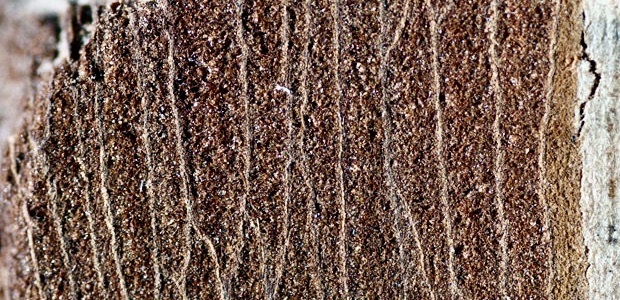
Section through bark
Comments are closed for this post.
